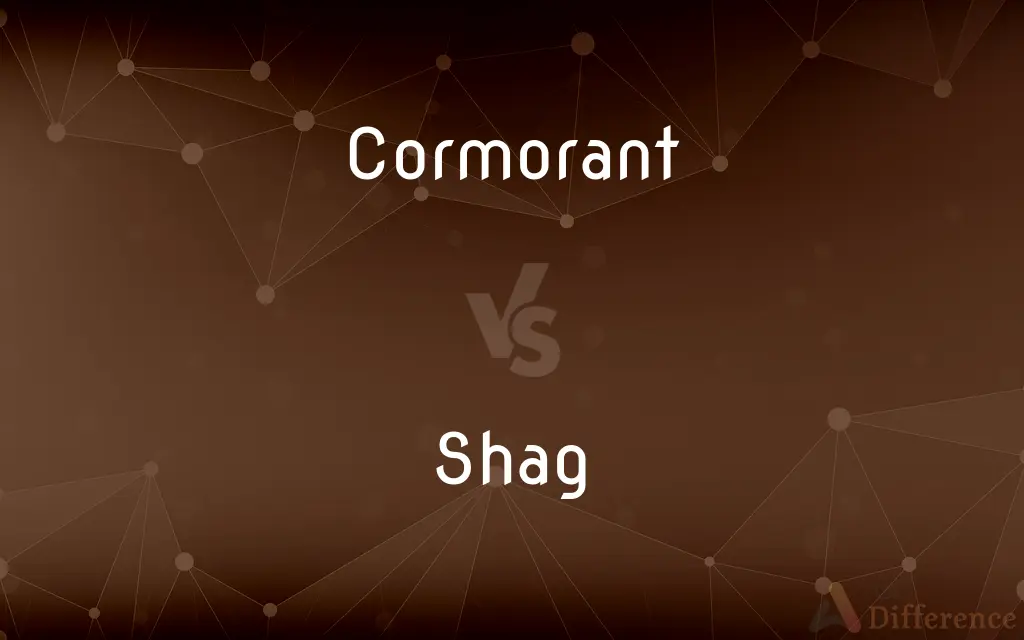Cormorant vs. Shag — What's the Difference?
By Maham Liaqat & Urooj Arif — Updated on March 18, 2024
Cormorants are large water birds known for their expert diving to catch fish, while shags, often considered a subtype, typically have a slimmer profile and crest.

Difference Between Cormorant and Shag
Table of Contents
ADVERTISEMENT
Key Differences
Cormorants are notable for their size and black plumage, adept at diving to catch fish in fresh and salt waters. They have a broad distribution worldwide, adapting to various aquatic environments. Whereas shags, often regarded as a subset of the cormorant family, are distinguished by their more streamlined bodies and sometimes by the presence of a crest during the breeding season. While all shags are cormorants, not all cormorants are considered shags, a distinction more commonly recognized in the British Isles.
Cormorants are well-known for their ability to dive deep and swim underwater to hunt fish. They have specialized feathers that get wet, allowing them to sink and swim efficiently. On the other hand, shags share this diving capability but are often found in coastal regions, suggesting a specialization in marine environments compared to the broader habitat range of cormorants.
The drying behavior of cormorants, where they are often seen with wings outstretched, is a common sight across many species within this family. This behavior aids in drying their feathers since they lack the oil glands that many other water birds have for waterproofing. Shags, sharing this trait, also display similar behavior but their habitats often influence where and how they dry their wings, typically preferring rocky coastlines for perching and drying.
In terms of social behavior, cormorants can be found in large colonies for breeding and often form flocks while feeding. They have a variety of vocalizations used in social interactions within colonies. Shags, while also colonial, may form smaller, more dispersed colonies and tend to be less vocal, highlighting subtle differences in social behavior and communication.
The diet of cormorants is quite varied, including fish, crustaceans, and, in some cases, small amphibians. Their hunting technique is versatile, allowing them to exploit different aquatic environments. Shags, by contrast, have a diet that is heavily focused on fish, particularly those found in marine settings. This dietary specialization reflects the habitats they are most commonly associated with and their adaptation to coastal living.
ADVERTISEMENT
Comparison Chart
Profile
Larger, bulkier body
Slimmer with a crest during breeding
Habitat
Fresh and salt waters worldwide
Primarily coastal marine environments
Diving Behavior
Deep diving with wettable feathers
Similar diving, often in marine settings
Drying Behavior
Wings outstretched to dry
Similar, prefers rocky coastlines
Social Behavior
Large colonies, vocal
Smaller colonies, less vocal
Diet
Varied, includes fish and crustaceans
Primarily fish from marine environments
Compare with Definitions
Cormorant
Lives in large colonies during breeding season.
In spring, cormorants gather in large numbers, nesting in close proximity to each other.
Shag
Slim water bird with a crest, known for diving.
The shag, with its sleek body and crested head, dove into the ocean waves in search of fish.
Cormorant
Has a broad geographical distribution.
Cormorants can be found in habitats ranging from coastal waters to inland lakes.
Shag
Forms smaller breeding colonies than cormorants.
Shags nest in smaller, less dense colonies, often on inaccessible cliffs.
Cormorant
Displays unique wing-drying behavior.
After a dive, the cormorant perched on a rock, spreading its wings to dry.
Shag
Typically found in coastal marine environments.
Shags are a common sight along rocky coastlines, where they hunt for fish.
Cormorant
Large water bird known for its diving skill.
The cormorant dove from the sky, plunging into the lake to catch fish.
Shag
Diet is more specialized on fish.
Focused almost entirely on fish, the shag is an expert marine hunter.
Cormorant
Feeds on a variety of aquatic animals.
The cormorant's diet is quite diverse, including fish, shrimp, and occasionally small eels.
Shag
Shares the wing-drying behavior with cormorants.
Perched on a cliff face, the shag extended its wings, catching the breeze to dry off.
Cormorant
Phalacrocoracidae is a family of approximately 40 species of aquatic birds commonly known as cormorants and shags. Several different classifications of the family have been proposed and the number of genera is disputed, but in 2021 the IOC adopted a consensus taxonomy of 7 genera.
Shag
A tangle or mass, especially of rough matted hair.
Cormorant
Any of several large, widely distributed marine diving birds of the genus Phalacrocorax, having dark plumage, webbed feet, and a slender hooked bill.
Shag
A coarse long nap, as on a woolen cloth.
Cormorant
A greedy, rapacious person.
Shag
Cloth having such a nap.
Cormorant
Greedy; rapacious.
Shag
A rug with a thick rough pile.
Cormorant
Any of various medium-large black seabirds of the family Phalacrocoracidae which dive into water for fish and other aquatic animals, found throughout the world except for islands in the centre of the Pacific Ocean; specifically, the great cormorant (Phalacrocorax carbo).
Shag
Coarse shredded tobacco.
Cormorant
A voracious eater; also, a person who, or thing which, is aggressively greedy for wealth, etc.
Shag
A dance step of the 1930s consisting of a hop on each foot in turn.
Cormorant
Voracious; aggressively greedy.
Shag
Any of several cormorants, especially Phalacrocorax aristotelis of Europe and North Africa.
Cormorant
Any species of Phalacrocorax, a genus of sea birds having a sac under the beak; the shag. Cormorants devour fish voraciously, and have become the emblem of gluttony. They are generally black, and hence are called sea ravens, and coalgeese.
Shag
To make shaggy; roughen.
Cormorant
A voracious eater; a glutton, or gluttonous servant.
Shag
To perform or execute this dance.
Cormorant
Large voracious dark-colored long-necked seabird with a distensible pouch for holding fish; used in Asia to catch fish
Shag
To chase and bring back; fetch.
Shag
(Baseball) To chase and catch (fly balls) in practice.
Shag
Matted material; rough massed hair, fibres etc.
Shag
Coarse shredded tobacco.
Shag
A type of rough carpet pile.
Shag
Bacon or fat, especially if with some remaining hair or bristles.
Shag
A roughly-cut or torn-off piece of bread or cheese.
Shag
A deliberately messy, shaggy hairstyle.
Shag
Any of several species of sea birds in the family Phalacrocoracidae (cormorant family), especially the common shag or European shag, Phalacrocorax aristotelis, found on European and African coasts.
Shag
A swing dance.
Shag
(northwestern Ontario) A fundraising dance in honour of a couple engaged to be married.
Shag
(West Country) Friend; mate; buddy.
Shag
(transitive) To make hairy or shaggy; to roughen.
Shag
To hang in shaggy clusters.
Shag
(intransitive) To shake, wiggle around.
Shag
To masturbate.
Shag
To chase after; especially, to chase after and return (a ball) hit usually out of play.
Shag
To perform the dance called the shag.
Shag
(obsolete) Hairy; shaggy.
Shag
Coarse hair or nap; rough, woolly hair.
True Witney broadcloth, with its shag unshorn.
Shag
A kind of cloth having a long, coarse nap.
Shag
A kind of prepared tobacco cut fine.
Shag
Any species of cormorant.
Shag
Hairy; shaggy.
Shag
To make hairy or shaggy; hence, to make rough.
Shag the green zone that bounds the boreal skies.
Shag
A strong coarse tobacco that has been shredded
Shag
A matted tangle of hair or fiber;
The dog's woolly shag
Shag
A fabric with long coarse nap;
He bought a shag rug
Shag
A lively dance step consisting of hopping on each foot in turn
Shag
Dance the shag
Common Curiosities
Can both cormorants and shags dive?
Yes, both are excellent divers, using their webbed feet and streamlined bodies to catch fish underwater.
Where do cormorants live?
Cormorants live in a variety of aquatic environments, including both fresh and saltwater habitats around the world.
Are cormorants and shags the same?
Cormorants and shags belong to the same family, but shags are often considered a subgroup distinguished by physical traits like a slimmer body and sometimes a crest.
What distinguishes shags from cormorants?
Shags typically have a slimmer profile and may display a crest; they are more commonly associated with coastal marine environments.
Do cormorants and shags have the same diet?
While both primarily eat fish, cormorants have a more varied diet, including crustaceans and small amphibians, whereas shags focus more on marine fish.
Why do cormorants and shags spread their wings to dry?
Their feathers get wetter than those of other water birds, lacking the oil for waterproofing, so they dry their wings by spreading them in the sun or wind.
How do cormorants and shags hunt for food?
Both dive underwater, propelling themselves with their feet and streamlined bodies to catch prey.
Is the cormorant found in urban areas?
Cormorants can adapt to various environments and may be found in urban areas near water bodies.
How do shags select their nesting sites?
Shags often choose inaccessible cliffs or islands for nesting to reduce predation risks.
Are shags less social than cormorants?
Shags tend to form smaller, less dense colonies compared to the often larger colonies of cormorants.
Do shags have a special adaptation for diving?
Shags, like cormorants, have wettable feathers that allow them to dive efficiently by reducing buoyancy.
What is the breeding behavior of cormorants?
Cormorants breed in colonies, building nests in trees, on cliffs, or on the ground near water.
Share Your Discovery

Previous Comparison
Vessel vs. Pot
Next Comparison
Unit vs. SuiteAuthor Spotlight
Written by
Maham LiaqatCo-written by
Urooj ArifUrooj is a skilled content writer at Ask Difference, known for her exceptional ability to simplify complex topics into engaging and informative content. With a passion for research and a flair for clear, concise writing, she consistently delivers articles that resonate with our diverse audience.














































